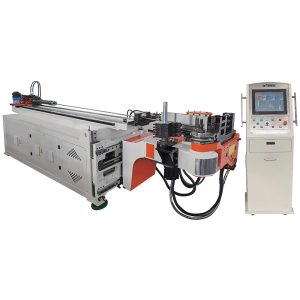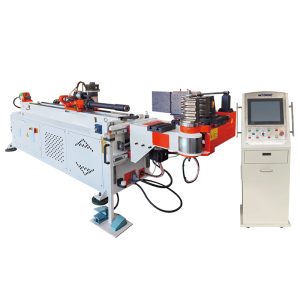One-stop Bending Solutions For Wires, Tubes And Pipes
One-stop Bending Solutions For Wires, Tubes And Pipes
In the aerospace industry, where precision and reliability are paramount, automatic pipe bending machines are core equipment for the manufacture of complex, high-precision piping systems, operating throughout the entire production process of aircraft, spacecraft, and engines. Compared to traditional manual or semi-automated methods, their intelligent and high-precision features perfectly meet the stringent standards of aerospace piping, laying a solid foundation for the safe operation of these equipment.
Ⅰ. Application Scenarios of Automatic Tube Bending Machines
The functions of pipelines in aerospace equipment vary significantly, resulting in significantly different bending requirements. Automatic tube bending machines achieve precise processing through process and tooling adjustments:
Fuel Systems: Aircraft and rocket fuel lines must withstand high pressure and be corrosion-resistant. Automatic tube bending machines offer integrated “cutting-bending-inspection” processing for materials like stainless steel and titanium alloys. Real-time pressure monitoring and die fit control prevent cracks and wrinkles in bent tubes, ensuring efficient and safe fuel transfer and eliminating the risk of leaks.
Hydraulic Systems: Hydraulic lines for flight control surfaces and landing gear require extremely high pressure resistance and tight seals. Automatic tube bending machines utilize high-precision CNC systems and specialized dies to achieve stress-free forming of high-strength alloy tubes. Optimized bending speeds and mandrel support parameters enable the pipes to withstand high pressures of hundreds of MPa and maintain a stable seal in extreme temperatures ranging from -50°C to 150°C. Pneumatic Systems: Oxygen delivery and air conditioning piping pursue lightweighting and low stress. Automatic pipe bending machines utilize flexible clamping and progressive processes to process thin-walled aluminum and titanium alloy tubes. For example, in oxygen piping, precise control of the bend angle and radius ensures the inner wall is free of impurities and oxide layer shedding, ensuring personnel safety.
Engine and Propulsion Systems: Aircraft engine piping utilizes nickel-based high-temperature alloys such as Inconel. Automatic pipe bending machines utilize cold bending (to enhance mold rigidity) or hot bending (with localized induction heating) to meet high-temperature and creep resistance requirements. Spacecraft propulsion systems transport liquid hydrogen (-253°C) and liquid oxygen (-183°C). The equipment utilizes specialized low-temperature molds and pretreatment processes to prevent low-temperature brittle cracking of the pipes and ensure sealing performance.

II. Technical Requirements for Automatic Tube Bending Machines
Aerospace piping standards are far higher than those in general industrial applications. Automatic tube bending machines must overcome multiple technical barriers:
1. Ultra-high Precision: Bend angle and position tolerances must be controlled within ±0.1°, with some piping requiring even higher requirements. The equipment is equipped with a high-precision CNC multi-axis linkage system, combined with laser in-line measurement, for real-time deviation detection and dynamic correction, eliminating assembly difficulties.
2. Complex Forming: Complex piping, such as multi-plane bends and S-shaped 3D curves, requires 6-axis or higher linkage technology, combined with 3D modeling for trajectory planning, enabling one-shot forming and improving efficiency and quality.
3. Material Compatibility: The equipment features a pre-configured process parameter library for different materials, such as titanium alloys and high-temperature alloys. It also incorporates anti-springback (real-time springback compensation) and wall thickness reduction control (reduction rate ≤5%, ≤3% for high-end equipment) to ensure pipe strength.
4. Non-destructive Processing: A built-in rigid/flexible mandrel prevents inner wall wrinkling, a ball-pressing process prevents cracking, and high-precision mold polishing prevents surface scratches, ensuring pipe fatigue life.
Ⅲ. Characteristics of automatic pipe bending machine fittings and equipment selection
The uniqueness of aerospace pipe fittings has promoted the upgrading of automatic pipe bending machine technology and also determined the direction of equipment selection:
(1) Core characteristics of pipe fittings
1. High material strength (mainly stainless steel and titanium alloy), requiring large forming force for bending;
2. Small bending radius (1-2 times the pipe diameter, some <1 times), which easily leads to thinning of wall thickness;
3. Large pipe diameter-to-wall thickness ratio (up to 130), thin-walled pipes are easy to deform;
4. Complex shapes and many short straight sections are difficult to meet with single-head equipment, requiring special clamping tooling;
5. Strict quality requirements (thinning rate, ovality, and surface finish are all high standards).
(2) Mainstream equipment types
Automatic pipe bending machine: mainstream choice, achieving complex paths through programming.
Servo electric automatic pipe bending machine: energy-saving and low noise, suitable for clean workshop environment.

IV. Advantages of Automatic Pipe Bending Machines
One-piece molding replaces welding, reducing leakage risks and improving reliability.
Lightweight design reduces equipment weight (e.g., aircraft fuel lines can be reduced by 10%-15%), optimizing performance.
Automated processing increases efficiency by 3-5 times compared to traditional methods, resulting in high quality consistency and low defect rates.
We have a professional R&D and production team and can provide customized automatic pipe bending machine solutions and technical support to help overcome processing challenges. If you require assistance, please contact us for comprehensive service and partnership solutions.
Our equipment has CE, ISO quality inspection certificate, so the quality is guaranteed to be cost-effective. According to different processing requirements, machines can be customized to fit for your usage, to provide customized services. In the processing period, we strictly control the production process, to ensure the quality of clearance, standardize the process, strict implementation.
